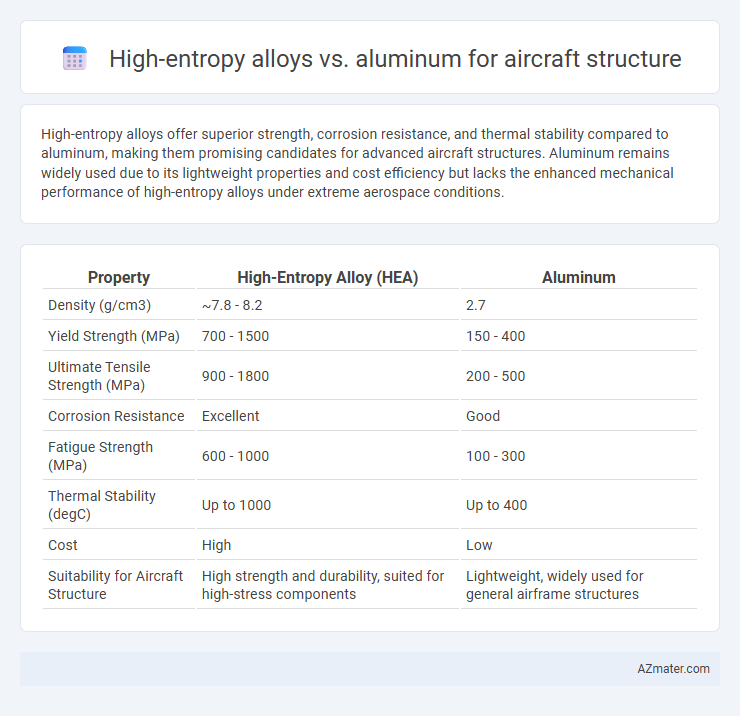High-entropy alloys offer superior strength, corrosion resistance, and thermal stability compared to aluminum, making them promising candidates for advanced aircraft structures. Aluminum remains widely used due to its lightweight properties and cost efficiency but lacks the enhanced mechanical performance of high-entropy alloys under extreme aerospace conditions.
Table of Comparison
| Property | High-Entropy Alloy (HEA) | Aluminum |
|---|---|---|
| Density (g/cm3) | ~7.8 - 8.2 | 2.7 |
| Yield Strength (MPa) | 700 - 1500 | 150 - 400 |
| Ultimate Tensile Strength (MPa) | 900 - 1800 | 200 - 500 |
| Corrosion Resistance | Excellent | Good |
| Fatigue Strength (MPa) | 600 - 1000 | 100 - 300 |
| Thermal Stability (degC) | Up to 1000 | Up to 400 |
| Cost | High | Low |
| Suitability for Aircraft Structure | High strength and durability, suited for high-stress components | Lightweight, widely used for general airframe structures |
Introduction to High-Entropy Alloys and Aluminum in Aviation
High-entropy alloys (HEAs) consist of multiple principal elements in near-equimolar ratios, offering exceptional mechanical strength, corrosion resistance, and thermal stability, which are critical for advanced aerospace applications. Aluminum, widely used in aircraft structures, provides a lightweight solution with excellent corrosion resistance and good strength-to-weight ratio, making it a traditional choice in aviation manufacturing. Comparing HEAs to aluminum involves evaluating enhanced performance metrics such as fatigue resistance and temperature tolerance, which could lead to the next generation of more durable and lightweight aircraft components.
Material Properties: Strength, Ductility, and Toughness
High-entropy alloys (HEAs) exhibit superior strength and toughness compared to conventional aluminum alloys, with yield strengths often exceeding 1,000 MPa versus aluminum's typical 200-400 MPa range. HEAs maintain enhanced ductility, with elongation values surpassing 20%, providing better deformation resistance critical for aircraft structural components. The combination of high strength, ductility, and fracture toughness positions HEAs as promising candidates to improve fatigue life and impact resistance in aerospace structural applications.
Density Comparison: Weight Implications for Aircraft
High-entropy alloys (HEAs) generally exhibit higher density values, typically ranging from 7.0 to 9.0 g/cm3, compared to aluminum's density of approximately 2.7 g/cm3. This significant density difference impacts aircraft structural weight, where aluminum's lower mass contributes to improved fuel efficiency and payload capacity. Selection between HEAs and aluminum depends on balancing structural strength with weight considerations critical for overall aircraft performance.
Corrosion Resistance in Aerospace Environments
High-entropy alloys (HEAs) exhibit superior corrosion resistance compared to aluminum alloys in aerospace environments due to their complex multi-element compositions forming stable passive oxide layers. Aluminum alloys, while lightweight, are more prone to pitting and stress corrosion cracking under aggressive conditions such as salt spray and humidity typical in aircraft operations. The enhanced corrosion resistance of HEAs contributes to improved durability and reduced maintenance costs in aircraft structural components exposed to harsh aerospace environments.
Temperature Stability and Performance
High-entropy alloys (HEAs) exhibit superior temperature stability compared to aluminum alloys, maintaining mechanical strength and structural integrity at elevated temperatures exceeding 600degC, which is critical for aircraft applications operating under extreme thermal conditions. Aluminum alloys typically lose strength above 200degC, limiting their use in high-temperature zones of aircraft structures. The enhanced performance of HEAs, including high fatigue resistance and corrosion resilience at elevated temperatures, positions them as promising materials for next-generation aerospace components requiring durability and reliability in harsh environments.
Manufacturing and Fabrication Processes
High-entropy alloys (HEAs) exhibit superior mechanical properties and corrosion resistance, but their complex multi-element compositions present challenges in casting, welding, and machining compared to aluminum alloys, which benefit from well-established, cost-effective manufacturing techniques such as extrusion and rolling. The fabrication of HEAs typically requires advanced processing methods like additive manufacturing and powder metallurgy to achieve homogenous microstructures, whereas aluminum structures rely on mature methods including forging and stamping, facilitating large-scale production and repair. Although HEAs have potential for enhanced performance, the aerospace industry favors aluminum for its predictable behavior, ease of fabrication, and extensive certification standards in aircraft structural components.
Fatigue Life and Structural Reliability
High-entropy alloys exhibit superior fatigue life compared to aluminum due to their complex microstructure, which enhances crack resistance and delays crack propagation under cyclic loading. The enhanced structural reliability of high-entropy alloys in aircraft structures results from their high strength-to-weight ratio and exceptional resistance to fatigue-induced failure, outperforming conventional aluminum alloys. Leveraging these materials in critical aircraft components can significantly improve durability and maintenance intervals, ensuring safer and longer service life.
Cost Analysis and Economic Considerations
High-entropy alloys (HEAs) generally exhibit superior mechanical properties and corrosion resistance compared to aluminum, but their manufacturing costs are significantly higher due to complex alloying and processing requirements. Aluminum remains economically favorable for aircraft structures because of its established supply chain, lower material cost, and ease of fabrication, resulting in reduced production and maintenance expenses. Evaluating cost-effectiveness involves balancing HEAs' enhanced performance benefits against aluminum's affordability and proven reliability in aerospace applications.
Sustainability and Environmental Impact
High-entropy alloys (HEAs) offer superior mechanical strength and corrosion resistance compared to traditional aluminum alloys, contributing to longer aircraft lifespan and reduced material replacement. Their manufacturing, often involving energy-intensive processes and rare elements, presents sustainability challenges, while aluminum benefits from well-established recycling infrastructure and lower embodied energy. Selecting HEAs over aluminum for aircraft structures requires balancing enhanced durability against environmental costs linked to resource extraction and production emissions.
Future Trends and Research Directions in Aircraft Materials
High-entropy alloys offer superior strength-to-weight ratios and enhanced thermal stability compared to traditional aluminum alloys, making them promising candidates for next-generation aircraft structures. Research is focusing on optimizing their corrosion resistance and manufacturability to match or exceed the extensive use of aluminum in aerospace applications. Future trends highlight the integration of high-entropy alloys with advanced additive manufacturing techniques to achieve complex, lightweight components with tailored mechanical properties.

Infographic: High-entropy alloy vs Aluminum for Aircraft structure
 azmater.com
azmater.com